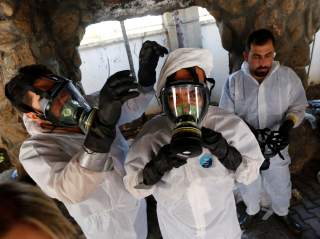Why Chemical and Biological Weapons Terrify the U.S. Army
Deadly and hard to stop.
But in Iraq, chemical weapons — at least — were becoming more common. Insurgents attacked U.S. troops around two dozen times with chlorine weapons during the course of the war, according to the New York Times.
The U.S. Army is worried its troops are not prepared for a biological or chemical attack. At the same time, chemical warfare is growing more common while it’s becoming easier for terrorists to cook up home-brewed bio-weapons in their basements.
“Not a lot” of soldiers are good at “at donning their mask in nine seconds,” Lt. Gen. Perry Wiggins, commander of U.S. Army North, told reporters Oct. 15 according to Air Force magazine. “We need to get back to the ‘B’ in CBRN.”
Wiggins deployed the acronym for chemical, biological, radiological and nuclear weapons. His larger point? Troops were going under-trained for a poisonous battlefield after years of counter-insurgency warfare in Iraq and Afghanistan.
But in Iraq, chemical weapons — at least — were becoming more common. Insurgents attacked U.S. troops around two dozen times with chlorine weapons during the course of the war, according to the New York Times. Hundreds of American service members were exposed to blister and nerve agents discovered in leftover Iraqi army stockpiles.
This would end up paling in comparison to Syria’s chemical war. On the morning of Aug. 21, 2013, the Syrian army fired bulbous, custom-made rockets loaded with sarin gas into rebel-controlled suburbs in eastern Damascus. Hundreds of people suffocated to death — most of them unarmed civilians.
There’s some evidence Islamic State has deployed chemical weapons in both Syria and against Kurdish forces in Iraq. These weapons are most likely chlorine and mustard gases, or another concoction that shares characteristics with them. It’s not clear whether Islamic State cooked up the chemicals itself or captured them from the Syrian army. It could be some combination.
What’s particularly unsettling is the repeated, scattered but credible reports of it from Kurdish forces on the receiving end. In short — we’ve entered a scary new age of low-level but persistent chemical warfare.
But Wiggins, the Army North commander, emphasized biological weapons as the greater threat. Perhaps a weaponized panflu, custom-built Henipavirus or modified MERS. Chemicals are easy to turn into a weapon, but tinkering with lethal organisms can sicken or, worst-case scenario, kill potentially millions of people.
“The threshold for participation in biotechnology is decreasing all the time: you don’t need to be a college educated microbiologist to do this any more,” Aaron Firoved, a senior biodefense adviser at the Department of Homeland Security, recently told the trade magazine CBRNe World.
Indeed, the U.S. Army’s problem isn’t just that soldiers don’t put their masks on fast enough during exercises. Chemical and biological weapons are by nature difficult to detect. They are briefly visible, if at all, disparate and insidious. What they have in common is the ability to inflict mass casualties before the victims are even aware of what’s happening.
In the 2009 manual Combating Weapons of Mass Destruction from the Army’s Training and Doctrine Command, the branch noted 17 “deficiencies” in its ability to counter such attacks. These ranged from lacking the ability to detect chemical and biological weapons, determining who is responsible and knowing where to shoot back.
That’s all on top of problems that come with soldiers having to fight in a bulky, kitted-out protective suit. Another problem — the Army “contracted a lot” of counter-CBRN work during the wars in Iraq and Afghanistan, Wiggins told Air Force magazine.
Image: Reuters

